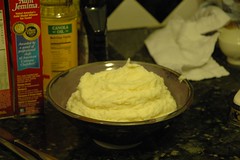Snow, wonderful snow
Sometimes, nature doesn't come through. Since there'll be a crowd of us at Mt. Wachusett a week from tomorrow, the topic of man-made snow achieved some currency among us at Mercredi gras today.
As the google-jockey of the group, I was assigned to research the topic and report back. Here's what I (and NT) found.
Well, that's probably more than you ever wanted to know about making snow.
As the google-jockey of the group, I was assigned to research the topic and report back. Here's what I (and NT) found.
Critical to snowmaking for skiing is getting the right combination of temperature and humidity--the lower the humidity, the higher the outdoor temperature can be to form snow. With untreated water, an air temperature of about –8 °C (18 °F) is needed. Another important factor is the need to generate sufficient nucleation sites for ice crystals to form. Nucleation sites can be a few water molecules that coalesce alone; calcium, magnesium, or other ions; or an impurity such as a clay particle or organic matter.
When the temperature isn't quite cold enough--above about –5 °C (23 °F)--snowmakers need little helpers in the form of seed materials added to the water to generate nucleation sites. Silver iodide, kaolin, soaps and detergents, and fungi or lichens are among the materials that have been used.
Currently, the most popular additive is Snomax, a freeze-dried protein powder sold by York Snow, Victor, N.Y. Snomax is derived from Pseudomonas syringae, a common bacterium found on grasses, trees, and vegetable crops. In the 1970s, plant pathologists studying the frost sensitivity of corn plants at the University of Wisconsin, Madison, discovered that the bacteria were responsible for initializing ice crystallization [Nature, 262, 282 (1976)].
[It also has its own web site. Ed.]
A newer seeding product taking the market by storm is called Drift, a liquid polyether-substituted trisiloxane produced by Aquatrols in Cherry Hill, N.J. Drift works as a surfactant to decrease the level of hydrogen bonding in water so the water can freeze more quickly, according to the company.
Well, that's probably more than you ever wanted to know about making snow.


0 Comments:
Post a Comment
<< Home